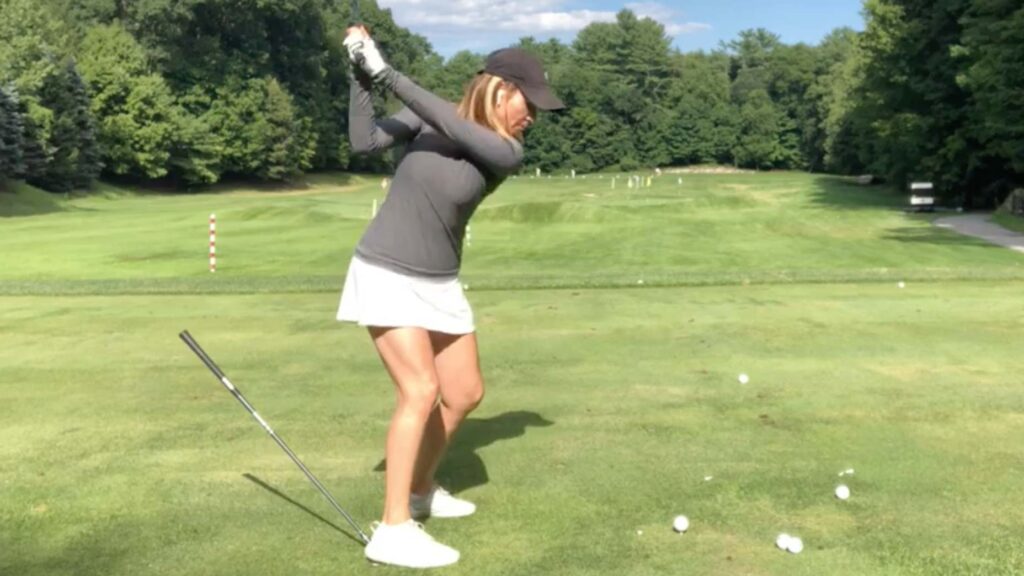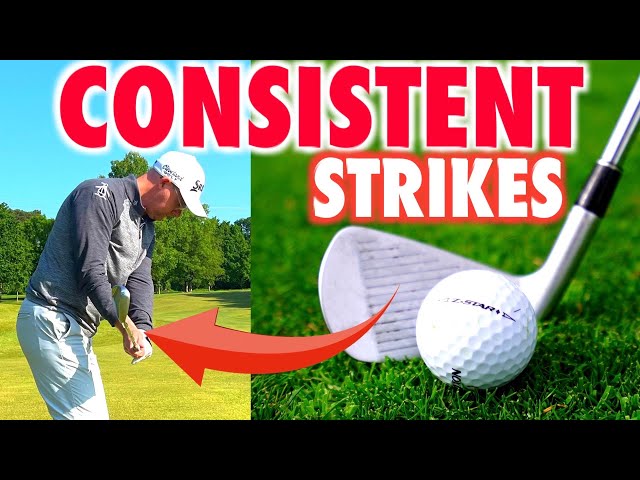If you’re a golfer looking to enhance your game, one crucial aspect to work on is your ball-striking consistency. The ability to consistently hit the ball flush and squarely is what separates conventional golfers from exceptional ones. But fret not, because there are several key techniques and drills that can help you improve your ball-striking consistency and take your game to the next level. By focusing on your grip, alignment, and swing tempo, and incorporating effective practice methods, you’ll be well on your way to achieving better ball-striking consistency and enjoying a more satisfying golfing experience.
Understanding Ball-Striking Consistency

Definition of Ball-Striking Consistency
Ball-striking consistency refers to the ability to consistently hit the golf ball with accuracy, power, and control. It encompasses elements such as solid contact, optimal trajectory, and consistent distance. When you have good ball-striking consistency, you are able to hit the ball consistently well regardless of the situation or the club you are using. This is crucial for achieving consistent scoring and overall success in the game of golf.
Importance of Ball-Striking Consistency
Ball-striking consistency is a fundamental aspect of golf that directly affects your performance on the course. Achieving consistent contact with the ball allows you to have more control over the outcome of your shots. It enables you to accurately predict the trajectory, distance, and flight of the ball, thus increasing your chances of hitting the target consistently. This not only helps you with your scoring but also boosts your confidence and enjoyment of the game.
Developing Proper Technique
Mastering the Grip
The first step in developing proper ball-striking consistency is mastering the grip. The grip is the foundation of your swing, and having a correct grip ensures that you have maximum control and power in your shots. To achieve a proper grip, place your left hand on the club (for right-handed golfers) with the pad of your left hand resting on the top of the club, and wrap your fingers around it. Then, place your right hand below your left hand, making sure that both hands work together as a unit. Practice your grip until it feels natural and comfortable.
Achieving a Stable Stance
A stable stance is essential for consistent ball-striking. Your stance provides a solid foundation and helps you maintain balance throughout your swing. To achieve a stable stance, position your feet shoulder-width apart, with the ball positioned slightly forward of center in your stance. Distribute your weight evenly on both feet and maintain a slight flex in your knees. This setup helps you maintain stability and control throughout your swing, resulting in better ball-striking consistency.
Maintaining a Balanced Setup
A balanced setup is crucial for consistency in ball-striking. Proper balance enables you to transfer your weight effectively during your swing, generating power and maintaining control. To achieve a balanced setup, ensure that your weight is evenly distributed between your feet. Keep your spine straight and your head centered over the ball. Avoid leaning too far forward or backward, as this can disrupt your balance and affect your ability to strike the ball consistently.
Swing Mechanics
Understanding and developing sound swing mechanics is a key component of achieving ball-striking consistency. The golf swing is a complex motion, but focusing on a few key principles can help improve your consistency. Key elements to pay attention to include maintaining a smooth tempo, keeping your swing on-plane, and maintaining proper sequencing from your backswing to your follow-through. Seek guidance from a golf professional to help you analyze and improve your swing mechanics, as they can provide valuable insights and techniques to enhance your ball-striking consistency.
Improving Timing and Contact
Timing in Golf Swing
Timing is crucial in achieving consistent ball-striking. It refers to the synchronization of your body movements and the club during your swing. Proper timing ensures that the clubhead makes contact with the ball at the ideal moment, delivering maximum power and accuracy. To improve your timing, focus on developing a rhythmic swing tempo and a smooth transition between your backswing and downswing. Practicing with proper timing will help you consistently make solid contact with the ball.
Optimizing Impact Position
The impact position is the moment of truth in ball-striking. It is the position where the club strikes the ball, and it significantly affects the outcome of the shot. A proper impact position involves having a forward-leaning shaft, with the hands leading the clubhead and the clubface square to the target. Focus on achieving this position at impact by practicing drills and paying attention to your body positioning throughout your swing. Consistently hitting the ball in the optimal impact position will greatly enhance your ball-striking consistency.
Finding the Sweet Spot
The sweet spot is the area on the clubface that produces the most efficient transfer of energy to the ball. Hitting the sweet spot consistently results in greater distance and accuracy. To find the sweet spot, practice hitting shots with different clubs and pay attention to the feedback you receive from each shot. Over time, you will develop a better feel for the sweet spot and be able to consistently make solid contact with the ball.
Focusing on the Clubface
The clubface is a critical factor in ball-striking consistency. The position and alignment of the clubface at impact greatly affect the direction and trajectory of your shots. To improve your ball-striking consistency, focus on maintaining a square clubface throughout your swing. Pay attention to your grip, your wrist position, and the rotation of your forearms to ensure that the clubface is consistently aligned with your target. This will help you achieve more consistent ball flight and accuracy.
Enhancing Body Control and Strength

Improving Flexibility
Flexibility plays a vital role in ball-striking consistency. A flexible body allows for a full range of motion in your swing, enabling you to generate power and maintain proper body positions throughout. Incorporate stretching exercises into your routine to improve your flexibility. Focus on stretching your shoulders, hips, and hamstrings, as these areas are particularly important in the golf swing. Improved flexibility will result in better body control and ultimately lead to more consistent ball-striking.
Building Core Stability
Core stability is essential in maintaining proper body mechanics during your swing. A stable core allows for a more controlled and efficient transfer of energy from your body to the club. Engage your core muscles by incorporating exercises such as planks, Russian twists, and medicine ball rotations into your fitness regimen. Building core stability will help you maintain control and balance throughout your swing, leading to improved ball-striking consistency.
Increasing Lower Body Strength
Strong lower body muscles contribute to a powerful and consistent golf swing. The lower body provides stability and generates the necessary power for a successful strike. Incorporate exercises such as squats, lunges, and calf raises into your strength training routine to develop lower body strength. Strong legs and hips will enable you to maintain a stable base and generate maximum power from the ground up, resulting in more consistent and powerful ball-striking.
Managing Mental and Emotional Factors
Developing a Pre-shot Routine
A pre-shot routine is a set of specific actions and mental processes that you carry out before each shot. Having a consistent pre-shot routine helps calm your mind, focus your attention, and prepare yourself mentally and physically for the shot. Develop a routine that includes visualizing the shot, aligning your body and clubface, and taking a few deep breaths to relax. A well-established pre-shot routine will help you approach each shot with confidence and enhance your ball-striking consistency.
Staying Focused and Present
Maintaining focus and presence of mind during your round is crucial for ball-striking consistency. It is important to stay fully engaged in the present moment, allowing you to make the necessary adjustments and decisions based on the current conditions. Avoid getting distracted by thoughts of past or future shots, and instead, focus on the present shot at hand. By staying focused on the process rather than the outcome, you will be better able to consistently strike the ball at your best.

Managing Pressure and Anxiety
Pressure and anxiety can negatively impact ball-striking consistency. Golf can be a mentally challenging game, especially when there is a lot riding on the outcome of a shot. Employ stress management techniques such as deep breathing, positive self-talk, and visualization to help alleviate pressure and anxiety. Practice mindfulness and learn to embrace the challenge rather than letting it overwhelm you. By managing your emotions effectively, you can maintain a clear mind and improve your ball-striking consistency under pressure.
Visualizing Successful Shots
Visualization is a powerful tool for improving ball-striking consistency. Use your mind’s eye to vividly imagine yourself hitting successful shots. Visualize the ball flight, the sound of contact, and the feeling of a well-struck shot. By repeatedly visualizing successful shots, you are training your brain to create an image of what you want to achieve. This mental rehearsal will enhance your muscle memory and increase your chances of translating visualization into reality, leading to more consistent ball-striking.
Analyzing Ball Flight and Feedback
Understanding Ball Flight Laws
Understanding the laws of ball flight can provide valuable insights into your ball-striking consistency. Factors such as impact angle, clubface angle, and swing path influence the direction, trajectory, and shape of your shots. Study the principles of the ball flight laws to gain a better understanding of how these factors affect your shots. By analyzing your ball flight, you can make adjustments to your swing and address any inconsistencies, leading to improved ball-striking consistency.
Utilizing Launch Monitors
Launch monitors are advanced technological tools that provide detailed data about your shots, including clubhead speed, ball speed, launch angle, and spin rate. Utilize launch monitors to analyze your shots and gather valuable feedback on your ball-striking consistency. This data can help identify areas for improvement and provide specific insights into your swing mechanics. Work with a golf professional who can help interpret the data and provide guidance on how to optimize your ball-striking consistency.
Evaluating Shot Dispersion
Shot dispersion refers to the pattern in which your shots are scattered around the target. Evaluating shot dispersion can provide important feedback on your ball-striking consistency. Use alignment sticks or markers to create a target area and hit shots towards it. Analyze the dispersion pattern and make adjustments to your swing or setup if necessary. By consistently evaluating shot dispersion, you can track your progress and make targeted improvements to your ball-striking consistency.

Receiving Professional Guidance
Seeking professional guidance is invaluable for improving ball-striking consistency. A qualified golf instructor or coach can provide expert analysis, personalized instruction, and targeted drills to help you develop a more consistent swing and strike the ball more reliably. By working with a professional, you can receive individualized feedback, identify areas for improvement, and establish a plan for long-term development. Their expertise and guidance will greatly enhance your ball-striking consistency.
Utilizing Practice Drills
Targeting Specific Areas of Improvement
Practice drills targeted at specific areas of improvement can help you address weaknesses and enhance your ball-striking consistency. Focus on drills that target your grip, stance, swing mechanics, timing, and contact. For example, practicing with alignment sticks can help improve your alignment and swing path, while using impact bags can enhance your contact and timing. Incorporate a variety of drills into your practice routine to ensure well-rounded improvement in all facets of your ball-striking.
Creating a Structured Practice Plan
A structured practice plan is essential for maximizing your improvement and achieving ball-striking consistency. Create a plan that includes specific goals, drills, and targets for each practice session. Allocate time for different areas of your game, such as short game practice, iron play, and driving practice. By having a structured practice plan, you ensure that your practice sessions have purpose and direction, leading to more productive improvements in your ball-striking consistency.
Incorporating Variability and Pressure
Incorporating variability and pressure into your practice sessions can help simulate on-course conditions and enhance your ball-striking consistency. Introduce different targets, lies, and shot shapes to challenge yourself and adapt to varying situations. Additionally, practice under pressure by setting specific goals or competing with others. This helps improve your ability to perform under challenging circumstances and translates to more consistent ball-striking on the course.
Getting Feedback from Training Aids
Training aids can provide valuable feedback and assist in developing ball-striking consistency. Utilize aids such as impact bags, alignment sticks, and swing motion analyzers to receive instant feedback on your swing mechanics, contact, and alignment. These aids can help you identify flaws in your technique and make necessary adjustments. Incorporate training aids into your practice routine to accelerate your improvement and develop a more consistent ball-striking ability.
Optimizing Equipment and Gear

Choosing the Right Golf Clubs
Choosing the right golf clubs is essential for optimizing your ball-striking consistency. Factors such as club length, shaft flex, and clubhead design can greatly impact your ability to strike the ball consistently. Ensure that your clubs are properly fitted to your physical attributes and swing characteristics. Golf club fitting professionals can help analyze your swing and recommend clubs that suit your unique needs, leading to improved ball-striking consistency.
Getting Properly Fitted
Getting properly fitted for your golf clubs is crucial for achieving optimal ball-striking consistency. A club fitting session involves analyzing your swing dynamics, body measurements, and shot tendencies to determine the ideal specifications for your clubs. This includes determining the correct shaft flex, club length, lie angle, and grip size. A professional club fitting ensures that your equipment is tailored specifically to your swing, maximizing your potential for consistent ball-striking.
Understanding Loft and Lie
Understanding the concepts of loft and lie is important for optimizing your ball-striking consistency. Loft refers to the angle of the clubface relative to the ground, while lie refers to the angle between the clubhead sole and the shaft. These factors greatly affect the trajectory and direction of your shots. Work with a golf professional or club fitter to understand the impact of loft and lie adjustments on your ball-striking consistency and make necessary modifications to your equipment.
Maintaining Equipment
Proper maintenance of your golf equipment is essential for consistent ball-striking. Keep your clubs clean, free from dirt, and well-maintained. Regularly check and tighten your club grips to ensure a secure connection between your hands and the club. Take care of your golf balls, ensuring they are in good condition and match your playing style. By maintaining your equipment properly, you will have more confidence in your gear and be better equipped for achieving ball-striking consistency.
Taking Lessons and Seeking Coaching
Finding a Qualified Golf Instructor
Taking lessons from a qualified golf instructor is a great way to improve your ball-striking consistency. Look for an instructor who holds professional certifications and has experience working with golfers of all skill levels. A good instructor will be able to identify your strengths and weaknesses, diagnose any swing flaws, and provide specific guidance on how to improve your ball-striking consistency. Seek recommendations from fellow golfers or consult local golf academies to find the right instructor for you.
Receiving Individualized Feedback
Receiving individualized feedback from a golf instructor is invaluable for improving your ball-striking consistency. An instructor can analyze your swing mechanics, provide feedback on your technique, and suggest drills and exercises to help you make the necessary improvements. They can also guide you on mental and strategic aspects of the game, ensuring that you approach each shot with confidence and focus. Regularly working with an instructor will accelerate your progress and help you achieve a consistent ball-striking ability.
Working on Specific Weaknesses
Identifying and working on specific weaknesses in your game is essential for improving ball-striking consistency. With the guidance of a golf instructor, identify areas that need improvement, such as your grip, posture, swing path, or timing. Focus on drills and exercises that specifically target these weaknesses. By systematically addressing your weaknesses, you can make targeted improvements and elevate your overall ball-striking consistency.
Establishing Long-Term Development
Improving ball-striking consistency is a long-term endeavor. Establishing a long-term development plan with the help of a golf instructor can provide structure and focus to your improvement process. Set realistic goals and work with your instructor to devise a plan that includes specific milestones and areas of emphasis. Regularly review and adjust the plan based on your progress. By committing to long-term development, you increase your chances of maintaining and improving your ball-striking consistency over time.
Developing a Consistent Practice Routine
Setting Goals and Objectives
Developing a consistent practice routine starts with setting clear goals and objectives. Determine what you want to achieve with your practice sessions, whether it’s improving a specific aspect of your game or enhancing overall ball-striking consistency. Set both short-term and long-term goals, and make them specific and measurable. By having these goals in mind, you can structure your practice routine to address specific areas of improvement and track your progress along the way.
Allocating Time for Practice
Consistency in practice is key to improving your ball-striking consistency. Allocate dedicated time for practice sessions in your schedule and make it a priority. Practice regularly, aiming for a balance between quality and quantity. Even short and focused practice sessions can be beneficial when done consistently. By dedicating time to practice on a regular basis, you develop muscle memory, reinforce good habits, and ultimately improve your ability to strike the ball more consistently.
Mixing Skill Development and Course Play
A well-rounded practice routine should include a mix of skill development and on-course play. Skill development focuses on refining specific aspects of your game, such as your swing mechanics, contact, and control. On the other hand, course play allows you to apply those skills in a simulated game setting, which helps bridge the gap between practice and real-world performance. Incorporate both elements into your routine to improve your ball-striking consistency in various situations.
Practicing with a Purpose
Practicing with a purpose ensures that your practice sessions are focused and productive. Avoid mindlessly hitting ball after ball without specific goals in mind. Instead, approach each practice session with a plan and a specific purpose. Whether it’s working on your grip, alignment, or timing, have a clear objective for each practice drill or exercise. By practicing with intention and a specific purpose, you can make targeted improvements to your ball-striking consistency.
In conclusion, improving ball-striking consistency is a multifaceted process that requires attention to various technical, physical, mental, and equipment-related factors. By understanding the key components of ball-striking consistency and following a holistic approach, you can develop a solid foundation for improving your game. Remember to focus on developing proper technique, enhancing body control and strength, managing mental and emotional factors, analyzing ball flight and feedback, utilizing practice drills, optimizing equipment and gear, and seeking professional guidance. With dedication, practice, and a positive mindset, you can gradually improve your ball-striking consistency and enjoy more success on the golf course.






